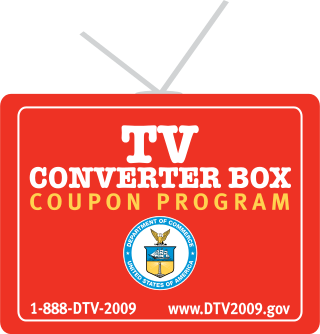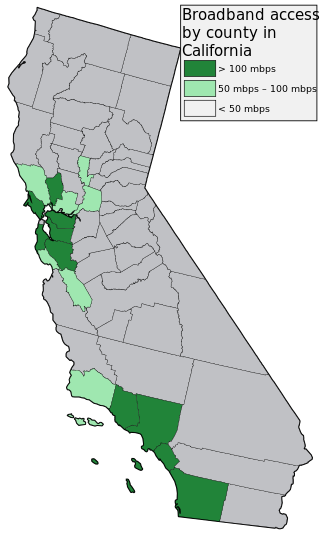
An Internet service provider (ISP) is an organization that provides myriad services related to accessing, using, managing, or participating in the Internet. ISPs can be organized in various forms, such as commercial, community-owned, non-profit, or otherwise privately owned.

The National Telecommunications and Information Administration (NTIA) is a bureau of the United States Department of Commerce that serves as the president's principal adviser on telecommunications policies pertaining to the United States' economic and technological advancement and to regulation of the telecommunications industry.

Network neutrality, often referred to as net neutrality, is the principle that Internet service providers (ISPs) must treat all Internet communications equally, offering users and online content providers consistent transfer rates regardless of content, website, platform, application, type of equipment, source address, destination address, or method of communication. Net neutrality was advocated for in the 1990s by the presidential administration of Bill Clinton in the United States. Clinton signed of the Telecommunications Act of 1996, an amendment to the Communications Act of 1934. In 2025, an American court ruled that internet companies should not be regulated like utilities, which weakened net neutrality regulation and put the decision in the hands of the United States Congress and state legislatures.
E-Rate is the commonly used name for the Schools and Libraries Program of the Universal Service Fund, which is administered by the Universal Service Administrative Company (USAC) under the direction of the Federal Communications Commission (FCC). The program provides discounts to assist schools and libraries in the United States to obtain affordable telecommunications and internet access. It is one of four support programs funded through a universal service fee charged to companies that provide interstate and/or international telecommunications services.
Municipal broadband is broadband Internet access offered by public entities. Services are often provided either fully or partially by local governments to residents within certain areas or jurisdictions. Common connection technologies include unlicensed wireless, licensed wireless, and fiber-optic cable. Many cities that previously deployed Wi-Fi based solutions, like Comcast and Charter Spectrum, are switching to municipal broadband. Municipal fiber-to-the-home networks are becoming more prominent because of increased demand for modern audio and video applications, which are increasing bandwidth requirements by 40% per year. The purpose of municipal broadband is to provide internet access to those who cannot afford internet from internet service providers and local governments are increasingly investing in said services for their communities.
The Universal Service Fund (USF) is a system of telecommunications subsidies and fees managed by the United States Federal Communications Commission (FCC) to promote universal access to telecommunications services in the United States. The FCC established the fund in 1997 in compliance with the Telecommunications Act of 1996. Originally designed to subsidize telephone service, since 2011 the fund has expanded its goals to supporting broadband universal service. The Universal Service Fund's budget ranges from $5–8 billion per year depending on the needs of the telecommunications providers. These needs include the cost to maintain the hardware needed for their services and the services themselves. In 2022 disbursements totaled $7.4 billion, split across the USF's four main programs: $2.1 billion for the E-rate program, $4.2 billion for the high-cost program, $0.6 billion for the Lifeline program, and $0.5 billion for the rural health care program.
In the United States, net neutrality—the principle that Internet service providers (ISPs) should make no distinctions between different kinds of content on the Internet, and to not discriminate based on such distinctions—has been an issue of contention between end-users and ISPs since the 1990s. With net neutrality, ISPs may not intentionally block, slow down, or charge different rates for specific online content. Without net neutrality, ISPs may prioritize certain types of traffic, meter others, or potentially block specific types of content, while charging consumers different rates for that content.

A coupon-eligible converter box (CECB) was a digital television adapter that met eligibility specifications for subsidy "coupons" from the United States government. The subsidy program was enacted to provide terrestrial television viewers with an affordable way to continue receiving free digital terrestrial television services after the nation's television service transitioned to digital transmission and analog transmissions ceased. The specification was developed by the National Telecommunications and Information Administration (NTIA), with input from the broadcast and consumer electronics industries as well as public interest groups.

The Internet in the United States grew out of the ARPANET, a network sponsored by the Advanced Research Projects Agency of the U.S. Department of Defense during the 1960s. The Internet in the United States of America in turn provided the foundation for the worldwide Internet of today.
Rural Internet describes the characteristics of Internet service in rural areas, which are settled places outside towns and cities. Inhabitants live in villages, hamlets, on farms and in other isolated houses. Mountains and other terrain can impede rural Internet access.

Julius Genachowski is an American lawyer and businessman. He became the Federal Communications Commission Chairman on June 29, 2009. On March 22, 2013, he announced he would be leaving the FCC in the coming weeks. On January 6, 2014, it was announced that Genachowski had joined The Carlyle Group. He transitioned from Partner and Managing Director to Senior Advisor in early 2024.

A national broadband plan is a national plan to deploy broadband Internet access. Broadband is a term normally considered to be synonymous with a high-speed connection to the internet. Suitability for certain applications, or technically a certain quality of service, is often assumed. For instance, low round trip delay would normally be assumed to be well under 150ms and suitable for Voice over IP, online gaming, financial trading especially arbitrage, virtual private networks and other latency-sensitive applications. This would rule out satellite Internet as inherently high-latency. In some applications, utility-grade reliability or security are often also assumed or defined as requirements. There is no single definition of broadband and official plans may refer to any or none of these criteria.
Connecting America: The National Broadband Plan is a Federal Communications Commission (FCC) plan to improve Internet access in the United States. The FCC was directed to create the plan by the American Recovery and Reinvestment Act of 2009, and unveiled its plan on March 16, 2010.

Broadband mapping in the United States are efforts to describe geographically how Internet access service from telephone and cable TV companies is available in terms of available speed and price. Mapping has been done on the national as well as the state level. The efforts are seen as preliminary steps towards broadband universal service.
Broadband universal service, also known as universal service obligation (USO) or universal broadband service, refers to government efforts to ensure all citizens have access to the internet. Universal voice service obligations have been expanded to include broadband service obligations in Switzerland, Finland, Spain and the UK.
ConnectEd is a United States Federal Government Initiative that aims to increase internet connectivity and technology in all public schools to enhance learning. The ConnectEd initiative is funded through Title IV Part A of the Every Student Succeeds Act (ESSA), which designates specific monies for the effective use of technology in schools. The 2016 National Education Technology Plan aligns with ConnectEd as a published action plan to meet these goals of technology integration and connectivity.
Lifeline is the Federal Communications Commission's program, established in 1985, intended to make communications services more affordable for low-income consumers. Lifeline provides subscribers a discount on monthly telephone service purchased from participating providers in the marketplace. Subscribers can also purchase discounted broadband internet from participating providers. The Lifeline program is funded by telephone fees as part of the Universal Service Fund.

The Infrastructure Investment and Jobs Act (IIJA), also known as the Bipartisan Infrastructure Law (BIL), is a United States federal statute enacted by the 117th United States Congress and signed into law by President Joe Biden on November 15, 2021. It was introduced in the House as the INVEST in America Act and nicknamed the Bipartisan Infrastructure Bill. The act was initially a $547–715 billion infrastructure package that included provisions related to federal highway aid, transit, highway safety, motor carrier, research, hazardous materials and rail programs of the Department of Transportation. After congressional negotiations, it was amended and renamed the Infrastructure Investment and Jobs Act to add funding for broadband access, clean water and electric grid renewal in addition to the transportation and road proposals of the original House bill. This amended version included approximately $1.2 trillion in spending, with $550 billion newly authorized spending on top of what Congress was planning to authorize regularly.

DISH Wireless L.L.C., doing business as Boost Mobile, is an American telecommunications company and wholly owned subsidiary of EchoStar Corporation. Boost Mobile is the fourth largest wireless carrier in the United States. Together with its sister brands Gen Mobile and Ting Mobile, it serves 7 million subscribers as of September 30, 2024.

Consumers' Research v. Federal Communications Commission, 67 F.4th 773 (2023), was a court ruling at the United States Court of Appeals for the Sixth Circuit, concerning a challenge by Consumers' Research against the Federal Communications Commission's Universal Service Fund program. The ruling was one of several at various American courts brought by the same litigants; the Sixth Circuit was the first to rule that the funding program does not violate the United States Constitution.











